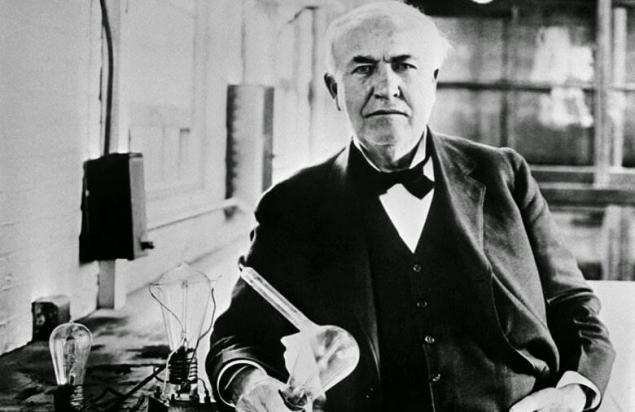600
10 most important discoveries, was not awarded the Nobel prize
The Nobel prize in physiology or medicine 2015 was awarded to three scientists for their pioneering work in the field of parasitic diseases. This began a yearly ritual, the "Nobel week" — a period of frenzied expectations and speculations, so his March fever for geniuses. And yet, looking at the whole stream of achievements and discoveries, it is easy to guess that not all great discoveries were awarded the Nobel prize.
Before you ten examples of discoveries and inventions that have not received "the Nobel prize", but definitely deserved it.

The world wide webAs says the correspondent of the National Geographic when he was asked in a Twitter question and topic offended inventions and discoveries, by which passed the Nobel prize, after collecting responses had to Google "Velcro", "dark matter", "embryonic stem cells" and read about these discoveries. And then it occurred to him: what could be more worthy of the Nobel prize than the invention, through which we can read about all these inventions?
After 60 years scientists in the Federal government the United States created a network of computer communications that eventually grew into the Internet. But the Nobel prize definitely deserved British scientist Tim Berners-Lee, who in 1989 proposed the idea of the world wide web (known as the World Wide Web, www, web) and in 1990 created the first website (a page describing the web).
The web has made information available, from silly video with dancing cats to fresh tweets from all over the world. And information is power.
Dark matterIf we dig the history, there are many astronomical discoveries worthy of a Nobel prize, as the laws of planetary motion Kepler's discovery of the expansion of the Universe early 20th century, the classification of stars by their spectral fingerprints. But the discovery of dark matter is a relatively fresh accomplishment that grossly neglected by the Nobel Committee.
In the 1970s, Vera Rubin and Kent Ford saw stars at the edges of galaxies were moving just as fast as stars near the center — in other words, galaxies are rotating so fast that it had to fly... if only something does not add the invisible gravity that holds them together from recession.
It is something invisible has become known as dark matter — the mysterious substance, which accounts for almost 90% of the mass of the Universe. It does not emit or reflect light by interacting with ordinary matter only through gravity.
Because of its secretive and unknown nature, dark matter particles also remain elusive. In short, scientists do not know exactly what it is. Perhaps this uncertainty is the reason why the Nobel Committee is silent about the discovery of dark matter, although prize in physics in 2011 went over like a mysterious cosmological discovery.
The first genome, Many people wonder why the Nobel prize was not awarded for one of the great achievements of science: the completion of the human genome in 2001. It's the most human of all human discoveries. For all its importance, the human genome wasn't a discovery, or invention, he was an engineering project that requires large-scale automated DNA sequencing on an industrial scale. As he said at the time, scientist of the human genome project Eric lander, "you will not get the Nobel prize for turning the handle".
But it is, in principle, for the very first turn of the handle. Six years before the completion of the human genome project Craig Venter and his colleagues had shown that automated DNA sequencing and a special technique of whole genome assemblies can be combined to read the entire code of a living organism, the bacteria Haemophilus influenzae. Their methods of work were essentially the same as that later used by a private company Venter for the sequencing of the genomes of Drosophila and humans, and the same used by other laboratories to compile the genomes of hundreds of other species. The Nobel Committee would be hard to choose the three scientists responsible for the first triumph of genomics. But Venter should be among them.
The death of a black holeOne night in 1970 Stephen Hawking was tossing and turning in bed when he came up with the idea of that filled him as he described later, "point of ecstasy". He thought that black holes, previously thought of as almost immortal, can slowly lose mass and gradually to evaporate, disappearing in a flash of gamma rays.
The problem is that then there was no way to test an idea. Black holes are too long live for today, we could see the demise of one of them. But research by Hawking black holes today are firmly embedded in theoretical physics. They combined the theory of relativity (a classical theory in which everything is smooth as silk) with quantum mechanics (in which all granular) and stimulate progress in the theory of information.
Perhaps Hawking would have received the award, if provided observable proof of his conclusions. But this will not happen for billions of years until you start to disappear the first black holes.
Periodic tableSometimes it is useful to return to basics. And what could be more basic, more fundamental and more significant than the identification of chemical elements?
The periodic table is not just an organizing scheme; it reveals the underlying order of protons, neutrons and electrons, which are at the heart of all matter. Its neat columns and rows the predicted elements before their actual discovery, together with their characteristics and qualities.
It seems incredible that such a breakthrough remains without scientific Lavrov, but this is what happened during the first Nobel prize award in 1901. Prize in chemistry went to Jacob H. van t Hoff for pioneering work in the field of physical chemistry. In comparison with the work of Hoff, showing how the items move, periodic table of Dmitri Mendeleev published in 1869, looked like a real pillar.
In Mendeleev was hope: he was nominated for the Nobel peace prize in 1905 and 1906, but lost, because the Committee felt his work was too old and well known. The periodic table became a victim of its own success.
In 1906 the prize was awarded to Henri Moisson for the detection of fluorine, exactly where he was supposed to be according to the periodic table. The following year Mendeleev died, and with it the claim to the Nobel. His table just became the most useful poster in science, which hung on a laboratory wall on an entire generation and continues to hang so far.
LightDespite the rapid development of technology, it would be remiss not to mention a stable glow "bulbs of Ilyich", appreciating his Nobel prize in physics. The modest invention of Thomas Edison first patented by Joseph Swan in the UK, but made practical by Edison — built the modern economy (and sleep deprivation), creating a huge demand for electricity, without which our present existence seems impossible.
Edison died in 1931, not seeing the "Nobel prize" for the light bulb — the symbol of scientific inspiration. It was a historic injustice. Alfred Nobel offered the invention and the inventors wish, but judges were inclined to estimate impractical things like increasing expansion of the Universe or the esoteric "God particle", which only annoyed physicists for their name.
QuarkMurray Gell-Mann received the Nobel prize in physics in 1969 for "his contributions and discoveries on the subject of classification of elementary particles and their interactions". But no prize is not awarded a special idea for which Gell-Mann is most famous for: the quark. These tiny constituents of matter are connected with the formation of protons, neutrons and other particles. Opening them (using pencil and paper, the most powerful tools of theoretical physics) led to the deeper understanding of the physical world. The wording of the quote was vague enough that "the Nobel prize" Gell-Mann could be considered a kind of lifetime achievement award, although he was only 40 years.
At that time, the existence of quarks, which he suggested five years earlier, was an ambitious and controversial assumption. A speech during the award passed by this idea, and some physicists believed that the scientist deserves a second "Nobel prize". Also it would need to award to George Zweig, who independently came to the same idea, and James Bjorken for experiments that helped the idea take root.
Synthetic theory of evolutionWhen in 1901 were distributed the first Nobel prizes, evolutionary biology was yet a young science.
At the time, biologists knew very little about how life has changed over generations. Some still questioned natural selection and other fundamental ideas of Darwin's theory of evolution.
Between 1920 and 1950, a group of scientists — geneticists, naturalists, paleontologists — figured out how mutations occur, how spread are the raw material of evolution. This new Outlook on life today known as the synthetic theory of evolution (or modern evolutionary synthesis). Their work opened the way for important advances in our understanding of the history of life.
The tree of lifeAt a time when scientists classify microbes on the basis of their forms, Carl Woese first proposed to classify them by comparing their genes.
His method brought to light the existence of previously unrecognized domain of life, the microscopic archaea. Scientists used his methods for cataloging the mixture of microbes that live in our bodies and affect our health, and also outlined the evolutionary relationships of organisms, both large and small.
Thanks to Woese, the tree of life gained a powerful trunk, more solid branches and twigs. Woese died in 2012, and the Nobel prize is not awarded posthumously, but this is absurd: that someone who fully discovered what life was refused due to something this trivial as death.
Renaissance dinosaurIn 1969, the Yale University paleontologist John Ostrom gave the name of one of the most important ever discovered. He named the animal dinosaur age of 110 million years, Deinonychus, Deinonychus, or "terrible claw". This lizard was a predator the size of a man with a prehensile limbs and long sickle-shaped claw on the second finger of the hind limbs.
More importantly, Ostrom knew that Deinonychus is very different from the usual dinosaurs as a rule, slow, stupid, swamp-living monsters. Deinonychus, he argued, was moving and, perhaps, social hunter, leading an active lifestyle. This assumption helped to start the "Renaissance of the dinosaurs", the fruits of which scientists collect so far.
Unfortunately, the Nobel prize in paleontology, or any other branch of natural history just no, Deinonychus is not getting it. What scientific discoveries and inventions have you noticed the Nobel prize? published
P. S. And remember, only by changing their consumption — together we change the world! ©
Join us in Facebook , Vkontakte, Odnoklassniki
Source: hi-news.ru
Before you ten examples of discoveries and inventions that have not received "the Nobel prize", but definitely deserved it.

The world wide webAs says the correspondent of the National Geographic when he was asked in a Twitter question and topic offended inventions and discoveries, by which passed the Nobel prize, after collecting responses had to Google "Velcro", "dark matter", "embryonic stem cells" and read about these discoveries. And then it occurred to him: what could be more worthy of the Nobel prize than the invention, through which we can read about all these inventions?
After 60 years scientists in the Federal government the United States created a network of computer communications that eventually grew into the Internet. But the Nobel prize definitely deserved British scientist Tim Berners-Lee, who in 1989 proposed the idea of the world wide web (known as the World Wide Web, www, web) and in 1990 created the first website (a page describing the web).
The web has made information available, from silly video with dancing cats to fresh tweets from all over the world. And information is power.
Dark matterIf we dig the history, there are many astronomical discoveries worthy of a Nobel prize, as the laws of planetary motion Kepler's discovery of the expansion of the Universe early 20th century, the classification of stars by their spectral fingerprints. But the discovery of dark matter is a relatively fresh accomplishment that grossly neglected by the Nobel Committee.
In the 1970s, Vera Rubin and Kent Ford saw stars at the edges of galaxies were moving just as fast as stars near the center — in other words, galaxies are rotating so fast that it had to fly... if only something does not add the invisible gravity that holds them together from recession.
It is something invisible has become known as dark matter — the mysterious substance, which accounts for almost 90% of the mass of the Universe. It does not emit or reflect light by interacting with ordinary matter only through gravity.
Because of its secretive and unknown nature, dark matter particles also remain elusive. In short, scientists do not know exactly what it is. Perhaps this uncertainty is the reason why the Nobel Committee is silent about the discovery of dark matter, although prize in physics in 2011 went over like a mysterious cosmological discovery.
The first genome, Many people wonder why the Nobel prize was not awarded for one of the great achievements of science: the completion of the human genome in 2001. It's the most human of all human discoveries. For all its importance, the human genome wasn't a discovery, or invention, he was an engineering project that requires large-scale automated DNA sequencing on an industrial scale. As he said at the time, scientist of the human genome project Eric lander, "you will not get the Nobel prize for turning the handle".
But it is, in principle, for the very first turn of the handle. Six years before the completion of the human genome project Craig Venter and his colleagues had shown that automated DNA sequencing and a special technique of whole genome assemblies can be combined to read the entire code of a living organism, the bacteria Haemophilus influenzae. Their methods of work were essentially the same as that later used by a private company Venter for the sequencing of the genomes of Drosophila and humans, and the same used by other laboratories to compile the genomes of hundreds of other species. The Nobel Committee would be hard to choose the three scientists responsible for the first triumph of genomics. But Venter should be among them.
The death of a black holeOne night in 1970 Stephen Hawking was tossing and turning in bed when he came up with the idea of that filled him as he described later, "point of ecstasy". He thought that black holes, previously thought of as almost immortal, can slowly lose mass and gradually to evaporate, disappearing in a flash of gamma rays.
The problem is that then there was no way to test an idea. Black holes are too long live for today, we could see the demise of one of them. But research by Hawking black holes today are firmly embedded in theoretical physics. They combined the theory of relativity (a classical theory in which everything is smooth as silk) with quantum mechanics (in which all granular) and stimulate progress in the theory of information.
Perhaps Hawking would have received the award, if provided observable proof of his conclusions. But this will not happen for billions of years until you start to disappear the first black holes.
Periodic tableSometimes it is useful to return to basics. And what could be more basic, more fundamental and more significant than the identification of chemical elements?
The periodic table is not just an organizing scheme; it reveals the underlying order of protons, neutrons and electrons, which are at the heart of all matter. Its neat columns and rows the predicted elements before their actual discovery, together with their characteristics and qualities.
It seems incredible that such a breakthrough remains without scientific Lavrov, but this is what happened during the first Nobel prize award in 1901. Prize in chemistry went to Jacob H. van t Hoff for pioneering work in the field of physical chemistry. In comparison with the work of Hoff, showing how the items move, periodic table of Dmitri Mendeleev published in 1869, looked like a real pillar.
In Mendeleev was hope: he was nominated for the Nobel peace prize in 1905 and 1906, but lost, because the Committee felt his work was too old and well known. The periodic table became a victim of its own success.
In 1906 the prize was awarded to Henri Moisson for the detection of fluorine, exactly where he was supposed to be according to the periodic table. The following year Mendeleev died, and with it the claim to the Nobel. His table just became the most useful poster in science, which hung on a laboratory wall on an entire generation and continues to hang so far.
LightDespite the rapid development of technology, it would be remiss not to mention a stable glow "bulbs of Ilyich", appreciating his Nobel prize in physics. The modest invention of Thomas Edison first patented by Joseph Swan in the UK, but made practical by Edison — built the modern economy (and sleep deprivation), creating a huge demand for electricity, without which our present existence seems impossible.
Edison died in 1931, not seeing the "Nobel prize" for the light bulb — the symbol of scientific inspiration. It was a historic injustice. Alfred Nobel offered the invention and the inventors wish, but judges were inclined to estimate impractical things like increasing expansion of the Universe or the esoteric "God particle", which only annoyed physicists for their name.
QuarkMurray Gell-Mann received the Nobel prize in physics in 1969 for "his contributions and discoveries on the subject of classification of elementary particles and their interactions". But no prize is not awarded a special idea for which Gell-Mann is most famous for: the quark. These tiny constituents of matter are connected with the formation of protons, neutrons and other particles. Opening them (using pencil and paper, the most powerful tools of theoretical physics) led to the deeper understanding of the physical world. The wording of the quote was vague enough that "the Nobel prize" Gell-Mann could be considered a kind of lifetime achievement award, although he was only 40 years.
At that time, the existence of quarks, which he suggested five years earlier, was an ambitious and controversial assumption. A speech during the award passed by this idea, and some physicists believed that the scientist deserves a second "Nobel prize". Also it would need to award to George Zweig, who independently came to the same idea, and James Bjorken for experiments that helped the idea take root.
Synthetic theory of evolutionWhen in 1901 were distributed the first Nobel prizes, evolutionary biology was yet a young science.
At the time, biologists knew very little about how life has changed over generations. Some still questioned natural selection and other fundamental ideas of Darwin's theory of evolution.
Between 1920 and 1950, a group of scientists — geneticists, naturalists, paleontologists — figured out how mutations occur, how spread are the raw material of evolution. This new Outlook on life today known as the synthetic theory of evolution (or modern evolutionary synthesis). Their work opened the way for important advances in our understanding of the history of life.
The tree of lifeAt a time when scientists classify microbes on the basis of their forms, Carl Woese first proposed to classify them by comparing their genes.
His method brought to light the existence of previously unrecognized domain of life, the microscopic archaea. Scientists used his methods for cataloging the mixture of microbes that live in our bodies and affect our health, and also outlined the evolutionary relationships of organisms, both large and small.
Thanks to Woese, the tree of life gained a powerful trunk, more solid branches and twigs. Woese died in 2012, and the Nobel prize is not awarded posthumously, but this is absurd: that someone who fully discovered what life was refused due to something this trivial as death.
Renaissance dinosaurIn 1969, the Yale University paleontologist John Ostrom gave the name of one of the most important ever discovered. He named the animal dinosaur age of 110 million years, Deinonychus, Deinonychus, or "terrible claw". This lizard was a predator the size of a man with a prehensile limbs and long sickle-shaped claw on the second finger of the hind limbs.
More importantly, Ostrom knew that Deinonychus is very different from the usual dinosaurs as a rule, slow, stupid, swamp-living monsters. Deinonychus, he argued, was moving and, perhaps, social hunter, leading an active lifestyle. This assumption helped to start the "Renaissance of the dinosaurs", the fruits of which scientists collect so far.
Unfortunately, the Nobel prize in paleontology, or any other branch of natural history just no, Deinonychus is not getting it. What scientific discoveries and inventions have you noticed the Nobel prize? published
P. S. And remember, only by changing their consumption — together we change the world! ©
Join us in Facebook , Vkontakte, Odnoklassniki
Source: hi-news.ru
Stylish interior for little money: a real example from Poland
Mitsubishi prepares for the premiere of a prototype of an electric crossover























